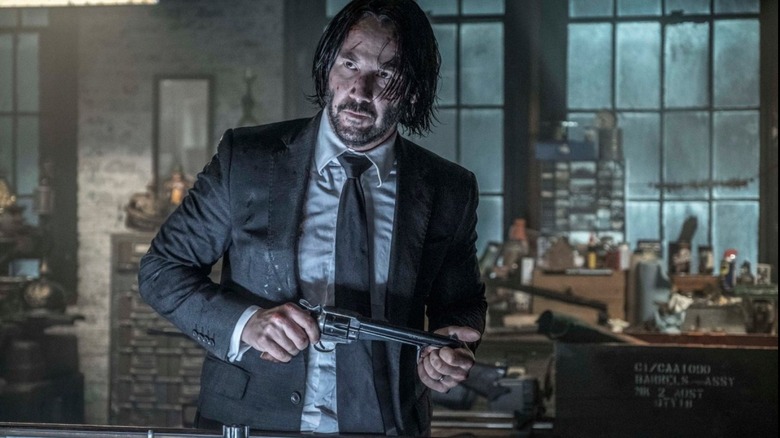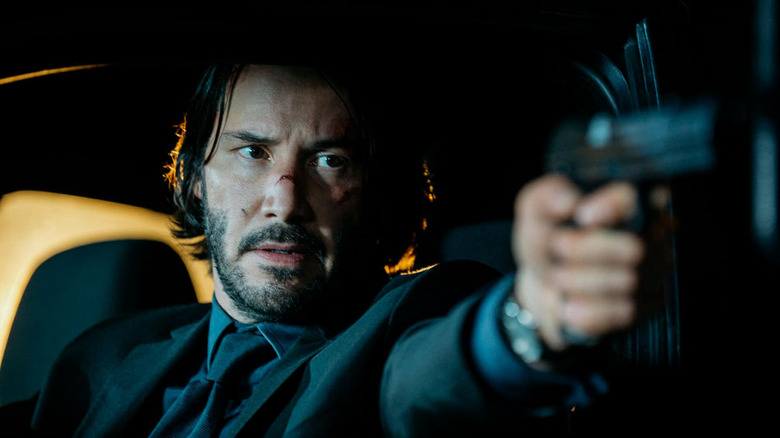John Wick Director Chad Stahelski Gets Candid About Why Live Firearms Are Still Used On Film Sets (But Not His)
The "John Wick" films feature some of the most gun-heavy action sequences in recent cinema history. In fact, the entire franchise is partly a resurrection of the popular "gun fu" style of martial arts action that came out of Hong Kong in the late nineties. However, director and stunt expert Chad Stahelski doesn't use the same type of blanks that can result in real-life deaths like the tragedies on the sets of "Rust" and "The Crow." According to Stahelski, filmmakers don't have to risk the deadly capabilities of blanks, either, since there exists technology that allows for much safer firearms practices during shoots. The director theorizes that it may be because of the backlog of guns in prop houses that productions continue to use more dangerous blanks to this day, despite not needing to.
Blank firearms have been a staple of filmmaking for decades, despite their potential for disaster. Incidents are relatively rare, which is why when deaths do happen they often cause a huge stir within the industry. The prop department used to handle firearms safety alongside other responsibilities, but in 1984, after actor Jon-Erik Hexum fatally shot himself during a game of Russian roulette on the set of the television series "Cover Up," the maintenance of prop guns became the exclusive domain of firearms experts. Blanks are deadlier than the name suggests, too, since the mere explosive force of the bullet-less blast alone is enough to cause concussive trauma, as was the case in the Hexum incident. As John Welsh, a sales worker from the largest supplier of Hollywood's prop guns ISS Props, puts it, "There is no such thing as 'just blanks.'"
Are guns gonna go?
Firearms experts like Dave Brown argue that intense safety protocols make firearms "as safe as any other prop on set" and that "blanks help contribute to the authenticity of a scene in ways that cannot be achieved in any other manner." Filmmakers like Stahelski, however, argue that a mix of electronic plug guns and CG effects have been able to replace the use of blanks on film sets and "that there's no reason to have a live firearm on set." In a THR interview, he goes on to argue that the reason why blanks are still in existence is to save costs:
"...for prop houses, armorers or supply houses to switch over, it would make their entire stock of real firearms useless. It comes down to the fact that it would cost certain people a great deal of money to switch over. No one wants to say that, but that's the real reason. You don't need firearms. The alternative is just going to cost you more money."
Producer Anna Halberg likewise stated that "It's oftentimes easier and more economical to actually discharge your weapon on set using a blank than it is to add a gun in CGI in post-production." Like other accidental on-set shootings in Hollywood history, the death of cinematographer Halyna Hutchins on the set of "Rust" caused a reassessment of the way the film industry handles firearms safety. Craig Zobel, director of the HBO series "Mare of Easttown," tweeted that blanks "should be fully outlawed," and showrunners like Alexi Hawley of ABC's "The Rookie" and Eric Kripke of Amazon's "The Boys" have pledged to switch to CG muzzle flashes. The debate rages on, but considering how many guns are in the "John Wick" movies, Stahelski presents a strong argument for firearms abstinence.

